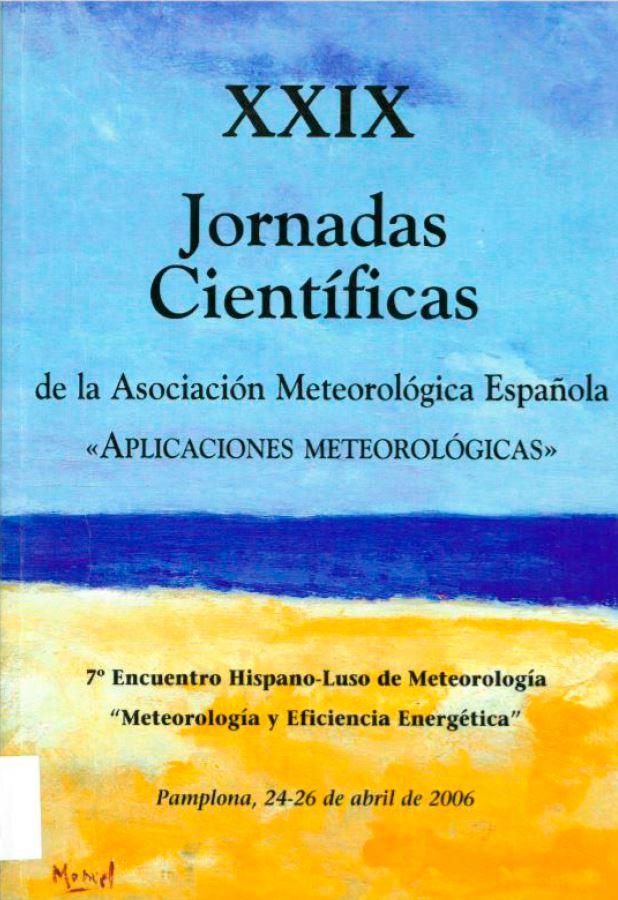Estudio de las alturas características de la capa límite atmosférica en situaciones estables obtenidas con tres métodos diferentes: sondeos con globo cautivo, observaciones micrometeorológicas en torre y ecuaciones de diagnóstico
Resumen
Este trabajo sobre altura de capa límite estable ha sido posible gracias a la disponibilidad de los datos recogidos en la campaña experimental SABLES 98 (‘Stable Atmospheric Boundary Layer Experiment in Spain’) que tuvo lugar en el Centro de Investigación de la Baja Atmósfera (CIBA) de Valladolid en septiembre de 1998. Estos datos pertenecen al intervalo horario de 18.00-06.00 GMT de 10 noches caracterizadas por tener diferente estabilidad de estratificación atmosférica y han permitido abordar este estudio con la obtención de tres grandes grupos de alturas de diferentes características que, a continuación se describen. El primer grupo de alturas (HS) se obtuvo a partir de datos de 78 sondeos con globo cautivo llevados a cabo hasta alturas máximas de unos 1000 m a los que se aplicaron varias definiciones de la altura de la capa límite atmosférica estable (CLE) reconocidas en la literatura científica micrometeorológica. Las definiciones seleccionadas están basadas en los siguientes parámetros: dos valores críticos del ‘Bulk Richardson Number’ ó Número de Richardson, un valor estándar del gradiente vertical de la temperatura potencial en la baja atmósfera, la altura de la inversión de temperatura en superficie y la altura del chorro de niveles bajos. Las salidas gráficas y numéricas de (HS) así como su evolución noche a noche permiten analizar y valorar el comportamiento de varias definiciones de la altura de la CLE y compararlas entre sí. El segundo grupo de alturas de la capa límite estable (HT) que se aborda se obtuvo a partir de datos medidos con instrumentos situados en una torre meteorológica de 100 m. Esta altura (HT) se define a partir de la propia expresión del Número de Richardson del gradiente exigiendo que éste último supere un valor crítico.Citas
André, J.C. and L. Mahrt (1982): “The nocturnal radiative surface inversion and the influence of clear-air radiative cooling”. J. Atmos. Sci., 39, 864 878. Arya, S.P.S. (2001): “Introduction to Micrometeorology”. (2nd Edition). International Geophysics Series. Academic Press, London, 307 pp.
Beljaars, A. (1992): “The Parameterization of the Planetary Boundary-layer”. Lecture series. ECMWF, 73pp. Clarke, R.H. (1970): “Observational studies in the atmospheric boundary layer”. Q.J.Roy. Soc., 96, 91 114. Conangla, L. and J. Cuxart (2005): “On the turbulence at the upper part of the low-level jet: an experimental and numerical study”. Bound.- Layer Meteor.,in press. Coulter,R.L. (1990): “A case study of turbulence in the stable nocturnal boundary layer”. Bound.-Layer Meteor., 52, 75-91. Cuxart, J., C. Yagüe., G. Morales, E. Terradellas., J. Orbe, J. Calvo, A. Fernández, M.R. Soler, C. Infante, P. Buenestado, A. Espinalt, H.E. Joergensen, J.M. Rees, J. Vilà, J.M. Redondo, I.R.Cantalapiedra, and Conangla, L. (2000): “Stable atmospheric Boundary layer experiment in Spain (SABLES 98): A report”. Bound.-Layer Meteor., 96, 337-370. Derbyshire, S.H. (1990), ‘Nieuwstadt’s stable boundary layer revisited’. Quart. J. Roy. Met. Soc., 116, 127 58. Estournel, C. and D. Guedalia (1985): “Influence of geostrophic wind on atmospheric nocturnal cooling”. J.Atmos. Sci., 42, 2695-2698. García, J.A., M.L. Cancillo, J.L. Cano, G. Maqueda, L. Cano and C. Yagüe (1997): “A study of the evolution of the nocturnal boundary-layer height at the central nuclear de Almaraz (Spain):Diagnostic relationships”. First International Conference on Measurements and Modelling in Environmental Pollution. Measurements and Modelling in Environmental Pollution. Computational Mechanics Publications. Southampton and Boston, 131-140, ISBN 1-85312-461-3. Garratt, J.R. (1982): “Observations in the nocturnal boundary layer”. Bound. Layer Meteor., 22, 21-48. Jiménez M.A. and J. Cuxart (2005): “Large-eddy simulations of the stable boundary layer using the standard Kolmogorov theory: Range of applicability”. Bound.- Layer Meteor., 115, 241-261. Joffre, S.M., M. Kangas, M. Heikinheimo, y S.A. Kitaigorodskii (2001): “Variability of the stable and unstable atmospheric boundary-layer height and its scales over a boreal forest”. Bound.- Layer Meteor., 99, 429-450. Johanson, C. and H. Bergström (2005): “An auxiliary tool to determine the height of the boundary layer”. Bound.-Layer Meteor., 115, 423-432. Melgarejo, J. W. and J.W. Deardorff (1974): “Stability functions for the boundary layer resistance laws based upon observed boundary-layer heights”. J. Atmos. Sci., 31, 1324-1333. Mahrt, L. (1981): “Modelling the depth of the stable boundary layer”. Bound.-Layer Meteor., 21, 3- 19. Nieuwstadt, F.T.M. and H. Tennekes (1981): “A rate equation for the nocturnal boundary layer height”.J. Atmos. Sci., 38, 1418-28. Seibert, P., F. Beyrich, S.E. Gryning, S. Joffre, A. Rasmussen and P. Tercier (1998): “Mixing Layer Depth Determination for Dispersion Modelling”. European Commission. In: B.E.A Fisher, J.J. Erbrink, S. Finardi, P. Jeannet, S. Joffre, M.G. Morselli, Pechinger, U., Seibert, P.,and D.J. Thomson, (Eds), 1998: COST Action 710 - Final Report. Harmonisation of the Pre-Processing of Meteorological Data for Atmospheric Dispersion
Models. L-2985 European Commission, Luxembourg, EUR 18195 EN (ISBN 92-828-3302-X). Stull, R.B. (1988): “An Introduction to Boundary Layer Meteorology”. Atmospheric Sciences library. Kluwer Academic Publishers, 666 pp. Yu, T.W. (1978): “Determining the height of the nocturnal boundary layer”. J. App. Meteor.,17, 28- 33. Zilitinkevich, S. S. (1989): ‘Velocity profiles, the resistance law and dissipation rate of mean flow kinetic energy in a neutrally and stably stratified planetary boundary layer’. Bound.-Layer Meteor., 46, 367-387. Zilitinkevich, S. S. and Mirinov, D.V. (1996), ‘A Multi limit formulation for the equilibrium depth of a stably stratified boundary layer’. Bound.- Layer Meteor., 81, 325-351. Zilitinkevich, S. S. and A. Baklanov (2002): “Calculation of the height of the stable boundary layer in practical applications”. Bound.-LayerMeteor., 105, 389-409.

